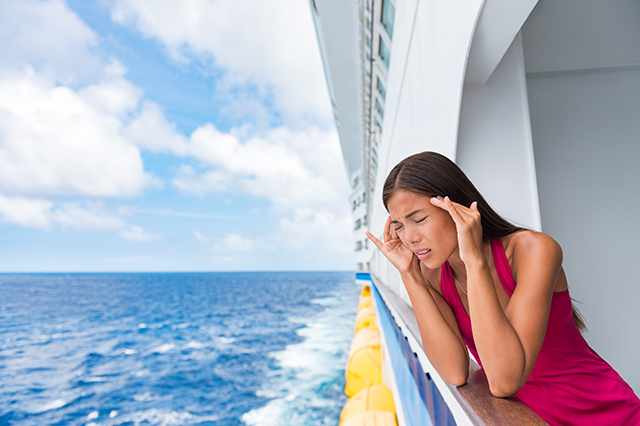Picture it. You’re on a huge cruise ship with your family. It’s the first day of your vacation and you’re all excited to experience your first cruise vacation. You haven’t even been on a boat many times in your life. Then, suddenly, the boat rocks a certain way, you hear the waves slap against the side of the ship and an unexpected but familiar feeling starts creeping up your throat. Oh no, you think.
When you and your family embark on the first of many cruise vacations, what is the worst thing that could happen to you? That’s right. Sea sickness. Or you can call it motion sickness. Either way, that unpleasant, nauseous feeling can overwhelm certain people when they embark on their first sea voyage.
What is motion sickness?
Travel means moving, but when we’re not moving under our own power, about 30 percent of us experience motion sickness.
“Any kind of conveyance makes people sick,” said Millard Reschke, chief of neuroscience at NASA’s Johnson Space Center in Houston.
Reschke has been studying the phenomenon for about 40 years, and with good reason: Around 70 percent of crew members on space missions get sick. Motion sickness occurs because of something called retinal slip, which you can see for yourself.
Hold your hand up and move your head back-and-forth, and you’ll see the lines on your palm clearly. Move your hand back-and-forth instead and the lines appear blurry. That’s what happens when we move in a space shuttle, car or on a boat, and that blurring or slipping of the image on the eye’s retina confuses the sensory system in the inner ear and makes (some of) us sick.
Essentially, your eyes are telling you that you’re moving and your inner ear is telling you that you’re not. That difference between expectation and reality seems to be what leads to feeling nauseous. It’s unclear why our bodies decide that nausea is the appropriate reaction, but one theory suggests that our evolutionary mechanisms are the cause.
Charles Darwin, originator of the theory of evolution, wrote about his expeditions on the sea in a letter to his father. “If it was not for sea-sickness, the whole world will be sailors,” he said.
Why do some get it and others don’t?
The answer to this question is also unclear, but there is evidence that suggests that genetics have something to do with it. Genetic company, 23andMe, found in a study that there are associations between motion sickness and genes involved in balance and eye and ear development.
But this then raises the question: How do people who are prone to motion sickness as children become less prone with time?
Another theory of the cause of motion sickness points to postural stability. On a ship, our bodies’ normal method of balancing is thrown way off course, making our bodies feel unstable. Around puberty, where we carry the most of our weight changes, and our methods of balancing change as well. So, someone who vomits during every long car ride at the age of 6 might start to fare better in his teenage years.
Of course, everyone is built differently; the unlucky few might just be more sensitive to motion than others.

Is there a sea sick remedy?
Our best bet is to try to limit the body’s confusion. “What I do about it is stop moving,” said Reschke. And if that isn’t an option? “I know you don’t want to hear ‘Look at the horizon and eat crackers, but it helps,” he said.
Another trick is a smart one for passengers in a car. The driver of a car is less susceptible to motion sickness because he can anticipate what’s coming. The answer is simple: pretend you’re the driver.
Though it’s harder to pretend you’re the captain of a ship than the driver of a car, trying your best to focus on where the ship is going might help.
A sea sick remedy that works for some is to consume gingery food and drinks. As a general health tip, drinking ginger ale can calm an upset stomach, but has been more so proven to be effective when the nausea is caused by motion sickness. It can also work as a placebo. If junior is complaining of motion sickness, tell him ginger ale is a 100 percent effective cure, and he might just believe you.
The other option requires less effort but much more determination – wait it out. Over time, our bodies get used to the motion. If you can get through the initial discomfort (and potential upchuck), you’ll be golden in time, and ready to enjoy the rest of your vacation.
Don’t get too used to the motion, though. You might find yourself feeling land sick once the cruise is over!
What’s your home remedy for sea sickness? Tell us in the comments below!
Don’t let motion sickness scare you from a cruise vacation of a lifetime! Plan and book your next cruise with AAA.
2 Thoughts on “What Causes Motion Sickness on Cruise Vacations?”
Leave A Comment
Comments are subject to moderation and may or may not be published at the editor’s discretion. Only comments that are relevant to the article and add value to the Your AAA community will be considered. Comments may be edited for clarity and length.













I have cruised many times and I take a Ginger pill each day and wear seabands. It is true you get your sea legs pretty quickly. Eventually you might not need to take or wear anything. I have also heard that the crewman on the ship sometimes get seasickness and they swear eating green apples help.
I wore Sea-Bands on my honeymoon and loved them! Don’t know how they work, but they did.